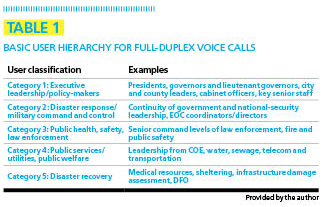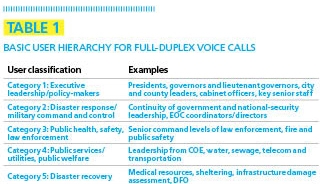Priority is the priority
The nationwide 700 MHz broadband network that has been proposed for first responders would be a mission-critical, multiagency, multijurisdictional, multi-service network that eventually would be capable of supporting voice, data and video. Negotiating, in advance, who gets what access when the network is under extreme stress is essential to its successful and effective operation. Priority and pre-emption are important considerations, and not just in the event that public safety shares this network with civilians.
In fact, whether public safety ends up with a network it shares with commercial customers or its own dedicated network, priority, pre-emption and graceful degradation cannot be overlooked and are worthy of serious debate — for both the end-users and those responsible for the network’s technical implementation.
Before we can talk about what all of this means to public safety, we need to familiarize ourselves with the difference between a broadband communications channel and narrowband two-way channels. A narrowband two-way communications is a discrete link; when there is an ongoing transmission on a channel, it is not available for another simultaneous transmission. However, in a broadband network, many people can be using it for many different purposes — including voice, data and video — simultaneously. For the purposes of this article, we will call these uses “services,” and will refer to an active service as a “session.”
In a traditional narrowband two-way system, a priority call is one that is first in line for the next available channel; meanwhile, pre-emption drops an ongoing call to make room for another presumably more important call. But there are considerably more possibilities to be considered in a mission-critical broadband network such as the one that has been proposed. One of the most important is that users must get used to sharing the network, something that might be foreign to them. However, if it is done right, all users will be well-served by the network.

Homework needs to be done in terms of deciding priorities when the need is greatest, i.e., during catastrophic events. Public safety needs to think in terms of such events and decide what services they can give up when they occur. Of course, all of this must be determined and preprogrammed into the network prior to the event.
A mission-critical broadband network also must be able to tell the difference between services — such as alerting, messaging, push-to-talk or simplex voice, full duplex voice, e.g., a telephone call, mission-critical data, automatic vehicle location data, automatic crash notification data and video — and then manage all of these services in a multi-dimensional hierarchy.
A one-dimensional, end-to-end hierarchy already has been defined for use in the Government Emergency Telecommunications System (GETS) and for Wireless Priority Services (WPS) for full-duplex voice calls. (See Table 1.) But a far more complex and intelligent mechanism is needed to deal with the multi-service networks that are being envisioned for the future.
These additional hierarchies are service-, incident- and resource-contingent. Services such as video consume much more bandwidth than alerting and P2T, for example. For this reason, it is reasonable to prioritize services based on their bandwidth requirements and, more importantly, their relative importance to protecting life and property. For example, a man-down alert would be prioritized over all other services. Not only does such an alert make use of very little bandwidth compared with other services, its timely reception may be crucial to saving a life. (See sidebar.)
Then there is the matter of the incident-related hierarchy. Clearly, an active emergency must be prioritized over routine operations. In this case, video from an active incident would be prioritized over routine data and video. However, regardless of an incident’s priority, sufficient bandwidth must be reserved for handling routine P2T traffic.
Finally, there needs to be a way to manage limitations in resources and, especially, ones that occur unexpectedly. This is where resource dependencies become relevant. As network resources are limited by traffic loading or the failure of a cell tower, it will be necessary to limit, or even temporarily eliminate, ongoing sessions. This approach is referred to as graceful degradation and in some cases may be a preferred option to complete pre-emption. An example would be an active emergency in which video is being transmitted to an emergency operations center. During the emergency, a nearby tower is compromised and the relative signal level drops at the incident scene. At that time, the video feed may have to be dropped in favor of supporting a minimum level of voice traffic, at the very least. Notification of the change in status could be broadcast utilizing a low bandwidth messaging service, so that users are not totally in the dark about what happened and why. In this sense, the network will be more user-friendly and perhaps a little less ruthless.
Admittedly, these are complex problems and getting it right will involve numerous different stakeholders and disciplines. On the other hand, public safety will benefit from the services that are available from a wireless broadband network — as long as steps are taken to ensure that the network is available and robust enough to provide service when it is needed most.
Some will be skeptical about whether this is doable and, therefore, will argue that the 700 MHz broadband network for first responders must be reserved only for data communications. But, even if that is the end result, it really does not solve the problem of who gets what and when. So, although a healthy level of skepticism will benefit us all, everyone in public safety needs to realize that priority, pre-emption and graceful degradation must be addressed, whether we are talking about a data-only network or a full, multi-service network. Therefore, a disciplined approach that deals with governance, levels of authority, a matrix of priorities and the technical means to implement them is necessary to make this network workable for all concerned.
Perhaps a regime that includes developing a working design that can be modeled, tested, implemented and validated is needed. This is likely to be an iterative process, involving periodic adjustments, in order to obtain constant and consistent improvements to the overall reliability and robustness of the network and the services running on it to support public-safety operations.
Fundamentally, managing competing interests for a mission-critical network always will be subject to debate and, as professionals, we all need to do our best to make sure that this piece of public infrastructure stays true to its mission: protecting and securing the public’s well being under all imaginable conditions. The first step is to recognize the challenges ahead and the second is to start working on the solutions to those challenges.
Ed Vea is the program manager for the NLECTC Communications Technologies Center of Excellence and a member of Urgent Communications‘ editorial advisory board.
Related Stories
- Ex-FCC engineering chief supports public-safety funding, pre-emptive roaming, not D Block
- The FCC places its bet
Potential service hierarchy, in descending importance
- Alerting
- Push-to-talk
- Text messages
- Mission-oriented data
- Full-duplex voice
- Video

















